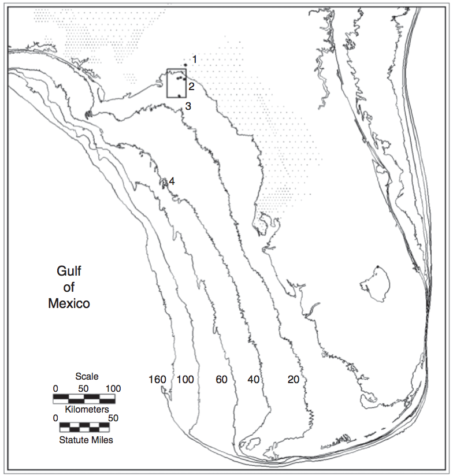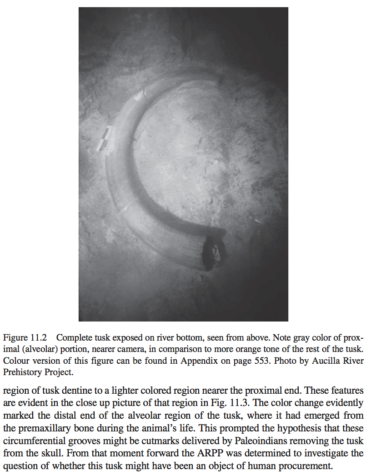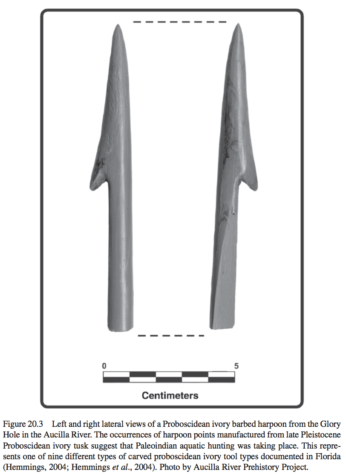
The Florida panhandle got some big press this week, yet another early human find confirmed in North America, people entrenched along the Aucilla River south of Tallahassee 14,550 years ago. This came from an underwater excavation where archaeologists have been plumbing a sinkhole through which the river flows. Artifacts and megafauna remains have gathered in the hole. A mastodon tusk shows clear butchering marks while it was fresh, and stone tools were collected in the vicinity.
When you hear news of these finds, what picture comes to mind? What kind of landscape are we in? It’s an important question to me. Archaeological finds are not what is seen in collection drawers and display cases, not photos in textbooks. They lose their color and context when they leave a place. They lose the sounds of the night, the burble of water. These objects are more than themselves. They tell a story of the earth around them, which in turn tells the story of the artifacts.
I visited the Aucilla River a few years ago in the lowland pine and palm forests of Florida’s Big Bend country. The river disappears holes; I’d never seen anything like it. It would come up again in a quarter mile, where it traveled a short distance through crowded palmettos and ferns, and went under again. Like stitching through fabric, the Aucilla flows in and out of a chain of sinkholes and skylights in dark and karstic earth. This is what preserves the archaeological and paleontological remains. The sinkholes act as time capsules. Archaeologists go down with SCUBA gear and spotlights, swimming into the underworld to find the past.
I came with a couple friends and parked the car on a clay road pooled with days-old rainwater where we walked into the forest. Not many people live around here. It is mostly heavily forested or chopped into pulpwood clear cuts with crackling high-power tension lines coming through.
The root beer-colored Aucilla circled into a limestone hole, what is called a suck. Where the water comes up again is called a rise. Driftwood and debris slowly rotated on the surface. The hole was big enough to swallow a school bus, and in sank the entire river. Dead and fallen trees disappeared in its depths. Roots, vines and palms leaned in all around it. End of the day, dim green light fell between branches and fronds.

Pete, a solo backcountry ranger who’d been working the granite domes and spires of Yosemite, stripped naked. With the agility of a monkey, he climbed down vines and roots and hung above the water. He was over a keyhole in the forest floor, a mouth inhaling a river. He dangled and let go. His body dropped underwater like a missile.
This was Pete’s off-season. He wasn’t thinking of alligators or drowning. He wanted to swim.
For a moment he was gone, only the shade of a ghost underwater. Vegetation and plant decay in the swampy headwaters of the Aucilla give the river its darkness. Pete kicked upward and broke through with a gasp.
“Come on!” he called.
Alex, who worked as a trail boss for a pick and shovel crew in the California Sierra, leaned through palmetto leaves and ferns looking into the hole. He was bug-bitten and dirty from many days in the field, crossing large parts of Florida by its waterways. I clung to the curved trunk of a palm tree next to him. We wanted to see if Pete was going to get sucked down. We didn’t know anything about this place, strangers in a strange land where the rivers can disappear into holes. Pete seemed fine. I looked at Alex. Alex shrugged. We stripped, tucked our clothes into the leaves, and cannonballed into the drink.
Bubbles rose from our noses, daylight feathering into the tannic water. Our bodies unfolded as we kicked upward. The water was from southern Georgia, passing into the Big Bend region of Florida where it emptied into the Gulf at Apalachee Bay. In its depths, like other sinkholes, this trap probably holds Ice Age treasures. The pits of the Aucilla have produced some of the oldest robust archaeological remains in the Americas. Underwater crews have gone in with SCUBA gear or air hoses from the surface where they dig and vaccum under the glare of spotlights, one person holding the light, one person excavating. The bones of domestic dogs have been found in the bottom-most human layers, the oldest known dogs on this side of the world, a sure sign of us.
Archaeologist Grayal Farr, who worked in SCUBA gear at a suck known as Sloth Hole along the Aucilla, told me about finding a foot-long sharpened point made from mammoth or mastodon ivory. It was a weapon meant for penetrating large animals, an early form of a lance. He described the excavation as, “30 feet down in strong coffee” where his underwater partner held the 1,000-watt light. Farr reached his arm into a limestone crack along the wall of the sinkhole, curious what he might find. As he pulled out the long weapon, he could hear his partner shouting excitedly into the water over his regulator. “It’s one of those hair-raising moments archaeologists have,” Farr said, “maybe the reason archaeologists are what they are. I was holding something made by someone no more recently than 13,000 years ago.”

When I told Farr that I thought of these sinkholes as “emergence points” for the first people, points of contact between then and now, he said you could also think of them as garbage cans. They are where everything came to rest, ivory tools and spearpoints made from tusks of mastodons or mammoths, barbed fish hooks made of deer bone, animals with wooden stakes or stone points driven into them, and bone pins that would have been used for clothing or shelters. Excavation reports found that anaerobic conditions left specimens in an unusual state of preservation, “including diverse plant remains, collagen-rich bone, and brain and other animal soft tissues.” The stomach of a mastodon was found intact at the bottom of an Aucilla sinkhole, and was cut open to reveal a diet of twigs, shrubs, grass and leaves. In another sinkhole, a Pleistocene turtle was found with a wooden stake wedged under its carapace, used to pry open the shell to get at the meat inside.
The way these remains swirl down toward the bottom makes me think of a Siberian story about mammoths. Recorded from the Mansi language, it reads, “The mammoth lives in a deep whirlpool: it has the shape of a fish, elk, bear, or horse. Animals and fish, when they become old and are about to die, fall into the whirlpool and are transformed into mammoths by the shaman of the Sky God.”
Looking down at my feet, which all but disappeared in the darkness, I floated in a slow circle, a history of tusks and spearpoints falling beneath me. I imagined lightless outcrops littered with fluted stone projectiles and mammoth bones. Currents swirled and tugged at my legs, urging me gently down, back to the beginning.
Images: Aucilla River Prehistory Project
Love the Mansi mammoth story.
SO INTERESTING. I knew none of this.